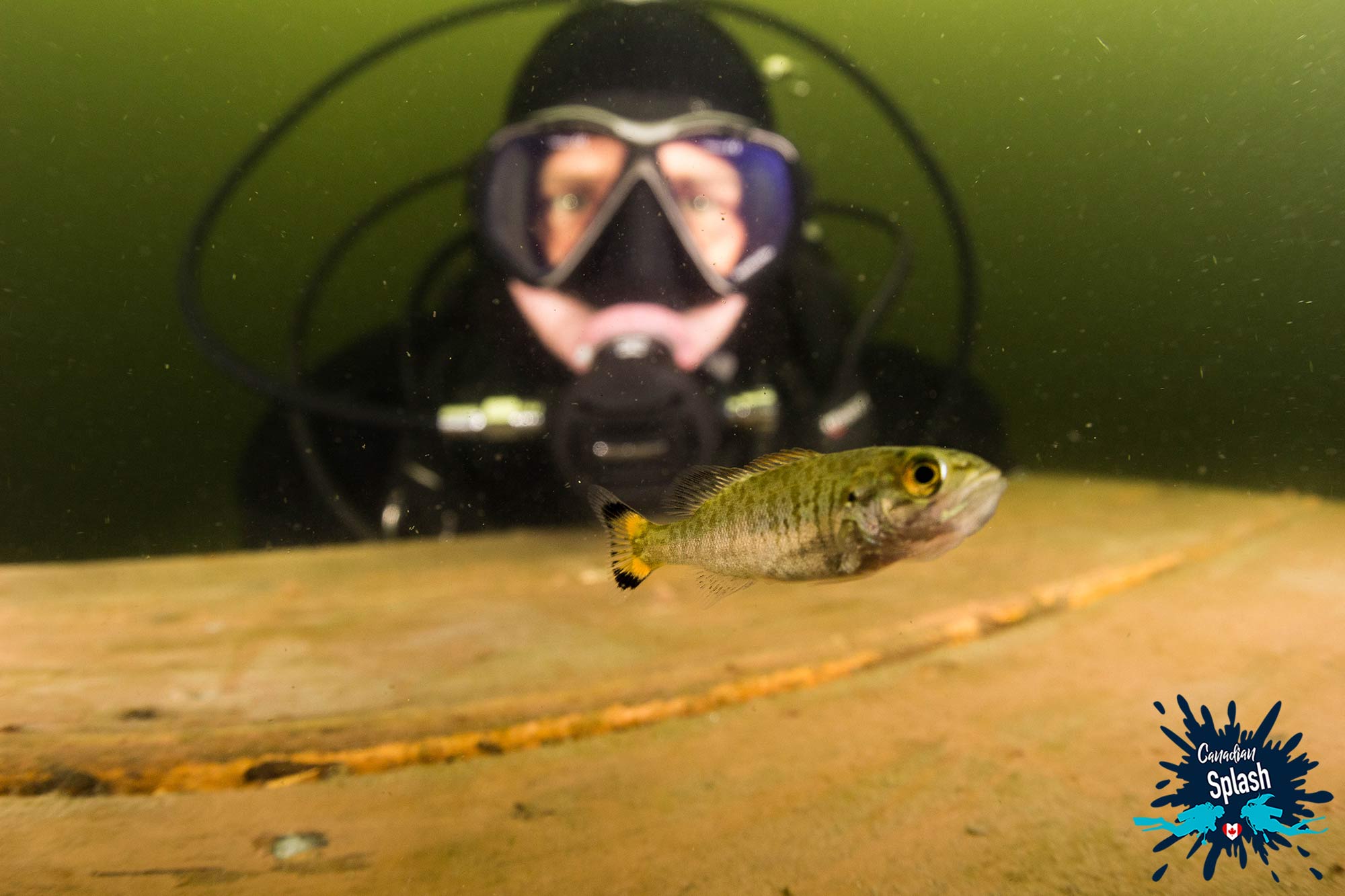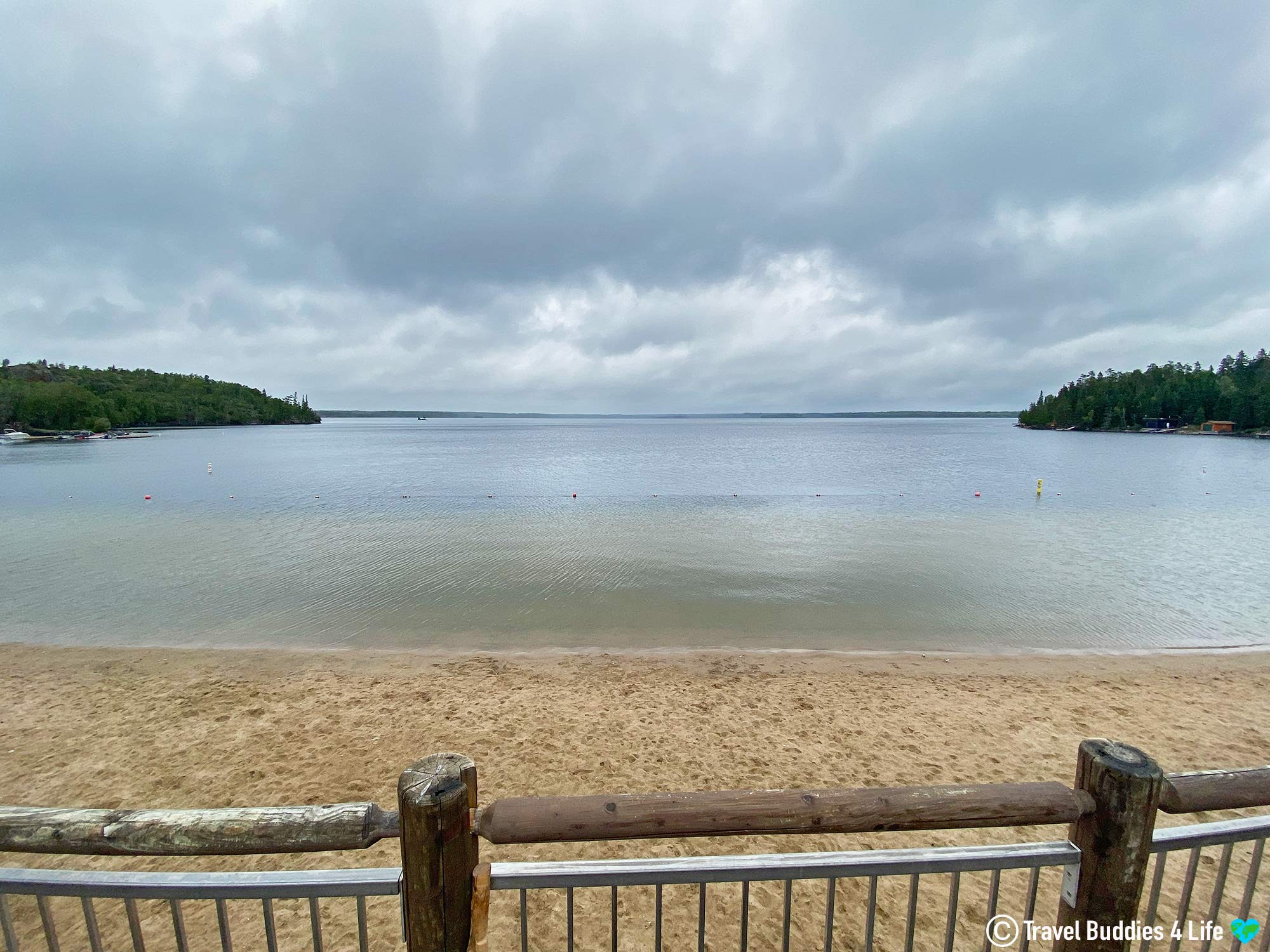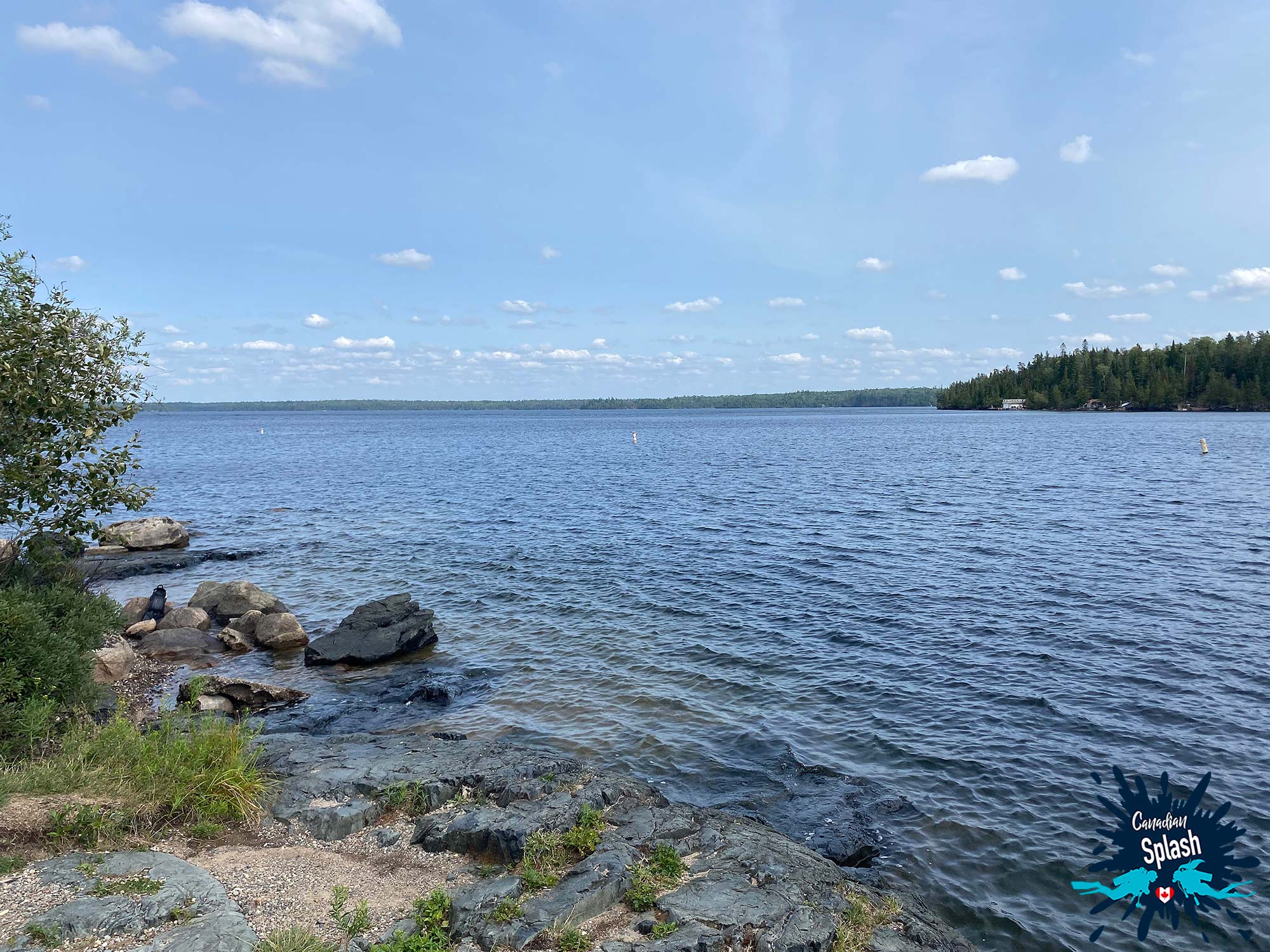Welcome to West Hawk Lake, where scuba diving transcends the ordinary and becomes a thrilling voyage into the heart of Manitoba. Here, travellers don’t stumble upon its serene shores by accident; they arrive with a purpose – to explore an underwater world of astronomical proportions.

Cradled within the heart of Whiteshell Provincial Park, West Hawk Lake reigns as a geological marvel, earning its rightful place among Manitoba’s most captivating natural wonders. This pristine body of water covers a total area of 3,685 acres, with a maximum length and width of 7.2 kilometers and 4.8 kilometers respectively. With its depth plunging to an astonishing 110 meters, West Hawk owes its existence to a cataclysmic event that unfolded 150 million years ago during a period of geological time known as the Jurassic Period. In a cosmic collision of celestial forces, a massive impact meteorite struck the Earth’s surface, leaving behind a colossal bowl-shaped crater. The tremendous explosion force of the impact has been estimated as being equivalent to that of a 25 Megaton blast. Over eons, this crater was subsequently eroded and modified by the scouring action of glacial ice, which retreated from South-Eastern Manitoba approximately 11,000 years ago. Meltwater from the retreating ice filled the crater forming what is known today as West Hawk Lake.

Escape to the lake in one of Manitoba’s most sought-after cottage areas. With vast, dense forests, plenty of wildlife and incredible lakes, Whiteshell cottages offer a beautiful selection of cabins and waterfront real estate ripe for the picking. Discover your home away from home in Whiteshell Provincial Park, located just over an hour’s drive from Winnipeg.
Yet, it’s not just the lake’s creation that captivates visitors; it also has a fascinating history. Indigenous peoples have inhabited this region for generations, their presence marked by rich cultural heritage and a deep connection to the land and water. The lake has witnessed centuries of stories, from indigenous traditions to early European exploration and settlement.
For modern-day adventurers, diving into West Hawk Lake isn’t just a journey into its depths; it’s an opportunity to connect with the past. This intersection of geological wonder, natural beauty, and historical significance makes West Hawk Lake an extraordinary place to explore holding secrets from a time long gone.

While West Hawk Lake, and Whiteshell Provincial Park, are renowned for their stunning surface views, what lies beneath the waterline of this Canadian destination is equally mesmerizing.
West Hawk Lake is one of the most popular diving sites in the province of Manitoba. This is in part because of its ease of accessibility and proximity to Winnipeg (about 1.5 hour drive) but also because of the interesting things seen beneath her cool clear waters.

Despite its northern location, West Hawk Lake is home to a surprising variety of aquatic life and an environment that supports this thriving ecosystem. The lake holds a range of fish species, including lake trout, whitefish, bass and perch, as well as other freshwater creatures such as crayfish and turtles. As scuba divers some of the species most likely to be encountered are perch, bass crayfish and turtles.
The lake offers several exciting dive sites and attractions. Divers can explore the underwater wreckage of boats and structures, witness the geological formations up close, and encounter unique submerged artifacts such as bathtubs, training platforms and a sunken canoe. Shore dive sites are both accessible and suitable for divers of various skill levels, making West Hawk Lake an ideal destination for divers looking to expand their experience.

Want to read about another great Manitoba scuba diving site? Head up north to the province’s Riding Mountain National park and dip your fins into Clear Lake. The lake is considered a unique lake for the prairie parkland thanks to its low amounts of nutrients, or oligotrophic nature. This gives it a clear look but also make it a suitable source of clean, fresh drinking water.

The Cat’s Ass dive site is the most frequently visited area within West Hawk Lake. It is a shore diving site situated off Section A of the campground. Divers typically enter the water directly from the point, which leads them to the edge of an underwater wall. This extensive wall and ledge system extends in a northerly and north-easterly direction for a considerable distance. Depths at the base of the wall vary, ranging from 7.6 meters (25 feet) to over 18.3 meters (60 feet). Along the base of the wall, divers can find various items to look at, including remnants such as a signpost, a bathtub, and a small boat. To the east of the dock, the rocky face descends to approximately 7.6 meters (25 feet), where there are two wooden platforms used for training exercises.

Where to Dive the Cat’s Ass
GPS Coordinates: 49.7458, -95.2093
Address: West Hawk Lake Campground, Manitoba, R0E 2H0
Entry is done off the point and from there divers can follow a rock wall down to the underwater playground.

A mere stone throw away from the Cat’s Ass diving site, along the northern and western shores of Blackpool, lies a relatively shallow area with a sandy bottom ranging from 6 to 7.6 meters (20 to 25 feet deep). This particular area features rocks and boulders of various sizes scattered across the bottom. Venturing further to the north-west, scuba divers will encounter an underwater landscape resembling a submerged forest. Here, numerous fallen trees are scattered across the lakebed at depths of ranging from 9 to 12 meters (30 to 40 feet). At the 9 meter (30 foot) mark divers are encouraged to keep their eye’s peeled for a substantial quartz vein gashed in the rock work.

Where to Dive Blackpool
GPS Coordinates: 49.7458, -95.2093
Address: West Hawk Lake Campground, Manitoba, R0E 2H0
Located very close to the Cat’s Ass dive site – along the northern and western shores. Use Cat’s Ass entry to reach this site.

Miller beach is another West Hawk Lake shore diving site that is located just two minutes away by car from the Cat’s Ass. A moderate snorkel is necessary to reach buoy positioned above the reef. The site’s reef tip is situated just 1.2 meters (4 feet) below the water’s surface, while descending along the walls will take divers to a silty bottom at depths of 13.7-15.2 meters (45-50 feet). This site is characterized by shorter walls.
During the summer season, divers can spot bass swimming above the thermocline, which typically forms at 10.6 meters (35 feet) in mid-July. Since this area experiences frequent boat traffic, it’s important to use a dive flag and exercise caution during ascent.

Where to Dive Miller Beach
GPS Coordinates: 49.7500, -95.2109
Address: West Hawk Lake Campground, Manitoba, R0E 2H0
Entry is done at the beach with a snorkel to reach the buoy and reef. A dive flag should be towed to keep boats away.

Dense forests embrace the water’s edge, and a striking shoreline adds to the spellbinding allure of West Hawk Lake. The thrill of exploring underwater worlds has taken us to various corners of the globe, but this time, we found ourselves diving into a hidden gem right here in our home country. West Hawk, a lake in Manitoba formed by a meteorite impact millions of years ago, beckoned with promises of adventure, and neither Joey nor I could resist the call of the deep.
With a splash I glide into West Hawk’s dark waters, a sense of anticipation and excitement courses through my veins. We had talked to several divers on their surface interval at the dive site, hilariously named Cat’s Ass, and they had given us a wealth of information with regards to topography, things to see and how to navigate. The initial shock of the cold water is quickly forgotten as I submerge into the liquid embrace of this natural wonder. Beneath the surface, a world crafted by meteor and man unfolds.

While not crystal clear – because we were diving in the middle of the summer months – the water had a dark green appearance to it and visibility was about 3 meters (10 feet). Perch and other finger length baitfish glint with silver as they flicker across the bottom. Plunging off the rocky ledge like and astronaut into space, Joey and I turn on our lights as we navigate this underwater terrain. Training platforms with a few fish lurking above and below materialized from the lakebed, then a windmill, and a sailboat. They were interesting finds, as was the bathtub, speedboat, canoe, a gnome garden and amazon ladies. Over the years, Manitoba divers had done a terrific job sinking things in strategic locations for unsuspecting scuba enthusiasts to find. Wondering in eager anticipation what else we might stumble across at this dive site kept us down in the cold for much longer than anticipated.


We did a fair amount of swimming, and ended our dive in the shallows to the north-west, also known as Blackpool dive site. This relatively shallow area with a sandy bottom peppered in rocks and boulders was where I was hoping to find some itty-bitty macro creatures to photograph.
Following a tanks swap and change in local, we did our second dive from the shores of Miller Beach. Once again the initial plunge into the cool water was invigorating. As we descended further, this dive sites wall-like geological features revealed themselves.
We bobbed along the reef using fixed lines that had been installed for easy navigation. Each line was like an underwater labyrinth bringing us this way and that until we ended up at an interesting sunken artifact. We marveled at the underwater rock formations, showcasing nature’s artistry with intricate nooks and crannies providing shelter for a variety of aquatic life. The lake’s resident fish population welcomed us into their world. Bass and perch were enthralled by our bubbles and we thoroughly enjoyed gazing into their vibrant orange eyes. After an hour of being underwater, we decided to head back to shore and call it a day.

West Hawk Lake is not just any ordinary lake; it’s a meteorite impact crater and as a result incredible depth and clarity, making it a captivating underwater world to explore. Diving into the depths of West Hawk was an adventure that took us to the heart of Canada’s scuba diving scene. The combination of fun underwater features, aquatic life, and the allure of exploring a geological wonder make this lake an unforgettable dive destination. It’s a testament to the incredible diversity of dive sites and unique places in Canada’s scuba diving landscape.

How unique is West Hawk Lake? Have you ever gone diving in a spot formed by a meteor impact?
Writers Note: This post may contain sponsored or affiliate links. We will make a small commission if you make a purchase through one of these links, at no extra cost to you. See full disclosure and disclaimer policy here.
Want to explore more diving in Manitoba? Take a look at our prairie province diving to discover more interesting Manitoba-based dive adventures.


Lake Superior is home to a smorgasbord of fish both big and small. Under the right season spotting fish aggregations are a real possibility.

Saskatchewan may be coined as the prairie wheat-growing province, but there are more than puddles to be scuba-dived in this landlocked place.

Riding Mountain National Park is an island of wilderness surrounded by a sea of farmland, forest and rippling lakes.

There is a lot to love about Québec. Dive into Les Escoumins and find some of the best scuba diving in the province's Côte-Nord.

Dive into Ontario's wreck junkie heaven. Tobermory's clear water and abundance of shipwrecks make it one of the top dive sites in Canada and the world.

There are more than 200 named lakes across the Temagami region. With the lakes being at the heart of this location's tourism, scuba diving is an activity worth exploring.

Newfoundland is a place chock-full of life, and scuba diving a whale boneyard is one of the many shore diving opportunities this Canadian province offers.

Located at the mouth of Fundy, there are many good reasons that the rocky coastlines of Grand Manan island would be ideal for scuba diving. Thanks to the ocean exposure and changing tides, the outer Bay of Fundy has some of the most dauntingly productive waters in Eastern North America.

Mattawa is a far cry from wonderful diving, but given the region’s strong connection to its waterways - through the Indigenous people, Voyageurs and logging industry - Mattawa begs to be explored.

Year after year Newfoundland enjoys large marine animal migrations, rich fisheries and icebergs floating down from Greenland, so it should come as no surprise that this province would pair well with scuba diving.

From age-old shipwrecks to lukewarm water, the Saint Lawrence Seaway is considered one of the go-to diving destinations in Ontario.

Do you want to try diving inside an aquarium? This unique Canadian location lets you experience scuba diving and up-close animal encounters like never before.

Saint Andrews by-the-sea may be small in size, but this summer town packs a pretty big dive punch for scuba divers willing to brave the Bay of Fundy's tides.

When it comes to getting outside and immersed in nature, Ontario Parks is at the top of the list. Not only do the parks boast magnificent nature, but it's hundreds of thousands of lakes make it a real treat for those who love the water.

Do you enjoy cold water wreck diving? This dive destination will let you experience the best shipwrecks and scuba diving opportunities on the Canadian east coast.

When diving in Nova Scotia where do you even begin? Do you start in Halifax the province's capital or do you wander beyond to see what the surrounding area has to offer?

Sometimes finding a good dive spot is easier said than done. Shore diving around Saint John, New Brunswick is a testament to how unpredictable the Bay Fundy can be.

Scuba diving Nova Scotia's Terrence Bay and everything wedged between Halifax and the famous Peggy’s Cove Lighthouse.

What unique aquatic life or geological features have researchers discovered in the depths of West Hawk Lake, and how do these findings contribute to our understanding of the local ecosystem?